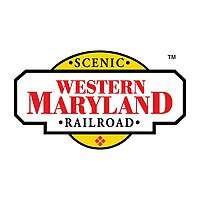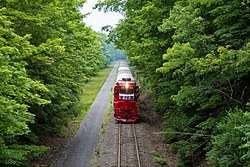Western Maryland Scenic Railroad
The Western Maryland Scenic Railroad (WMSR) is a heritage railroad based in Cumberland, Maryland. It operates over ex-Western Maryland Railway (WM) trackage to Frostburg, Maryland, and back using both steam and diesel powered locomotives.
 | |
 Western Maryland Scenic Railroad near Parkersburg Bridge | |
| Overview | |
|---|---|
| Headquarters | Cumberland, Maryland |
| Locale | Allegany County, Maryland |
| Dates of operation | 1988–present |
| Predecessor | Western Maryland Railway |
| Technical | |
| Track gauge | 4 ft 8 1⁄2 in (1,435 mm) standard gauge |
| Length | 16 mi (26 km) |
| Other | |
| Website | wmsr |
The WMSR operates passenger excursion trains and occasional freights when needed out of the former Western Maryland station in Cumberland, which also houses one of the six visitor centers of the Chesapeake and Ohio Canal National Historical Park as well as other attractions and offices. This station was built in 1913.
The railroad offers coach and first class service, as well as reserved caboose rides. The railroad also runs murder mystery excursions and special seasonal trips.
Rail line description
The track, which for the most part follows a former Western Maryland Railway line, proceeds northwest from Cumberland through "the Narrows", a deep water gap formed by the passage of Wills Creek between Haystack Mountain and Wills Mountain, parts of the Wills Mountain Anticline geological structure. The train then proceeds up the Allegheny Front through a water gap formed by Jennings Run, passes Mt. Savage, and terminates at the former Cumberland and Pennsylvania Railroad depot in Frostburg. The train lays over there for about 90 minutes to allow passengers to visit the town, and the locomotive is turned back there on a turntable that originally served the Western Maryland in Elkins, West Virginia. The train then returns to Cumberland by the same route.
Intermediate sights on the line include:
- Helmstetter's Curve in Cash Valley 39°40′43″N 78°48′25″W
- Brush Tunnel 39°41′24″N 78°48′50″W
- Woodcock Hollow, site of a hairpin curve 39°41′00″N 78°51′26″W
The Allegheny Highlands Trail of Maryland, part of the Great Allegheny Passage bicycle trail from Cumberland to Pittsburgh, Pennsylvania, runs along the route of the Western Maryland Scenic Railroad. Cyclists can make reservations with the railroad to put their bikes on board for the climb up the mountain to Frostburg, then cycle back down to Cumberland.
Shops
The WMSR operates out of the former WM's Ridgeley, West Virginia, car shops located just across the Potomac River from Cumberland. The shops include offices, a Federal Railroad Administration building, and the former paint shop which is now used to house the steam engine and perform repairs on the railroad's equipment. The WMSR shops also serve as a business offering restoration services for locomotives and coaches from both commercial and private owners. South, past the Ridgely shops and yard, the WMSR also maintains a wye that is used to turn the railroad's locomotives and coaches.
Passenger and Freight Equipment
Since its creation, the WMSR has gained an extensive collection of light weight style passenger coaches, many of which it either has restored to service in its tuscan and gold livery, or has used for parts to restore other coaches. Many of the restored coaches are painted with the names of local area towns, as well as benefactors of the scenic railroad. The WMSR also has a collection of freight equipment it has collected from CSX and other sources that it uses for storage at the shops, rail line maintenance, and photo freight excursions. The WMSR currently also has three cabooses. They are two ex-C&O cabooses and one ex-WM caboose. Other un-restored equipment includes an ex-Chessie System crane, ex-Amtrak material handling cars, heavyweight coaches and pieces for a turntable.
Locomotives
| Number | Builder | Type | Build date | Status | Notes |
|---|---|---|---|---|---|
| 734 | Baldwin Locomotive Works | Steam | 1916 | Inoperable | Normal power for the train is ex-Lake Superior and Ishpeming Railroad #34, now known as Western Maryland #734, a 1916 Baldwin-built 2-8-0 steam locomotive painted in WM "fireball" livery with a different tender from its original. It was originally built for the LS&I as #34. The locomotive came to the line from the Illinois Railway Museum in 1991. After an extensive rebuild, it entered service in 1992; it has received several modifications over the years to give it more of a WM appearance. The 734 was retired indefinitely after the 2015 season as well as some special excursion trips in February and April 2016 to undergo the 1,472 service-day Federal Railroad Administration inspection. It currently sits in a derelict condition on one of the yard's sidings. |
| 1309 | Baldwin Locomotive Works | Steam | 1949 | Undergoing restoration | In order to maintain its steam locomotive operations, the railroad obtained ex-Chesapeake and Ohio 1309 from the B&O Railroad Museum in Baltimore. On November 17, 2017, after failing to meet their projected summertime completion date for the C&O 1309 the railroad announced that the project had been put on hiatus.[1] However, in June 2018, it was announced that 1309 had passed its FRA hydro test and that restoration work was resumed.[2] In early October 2018, 1309 had its first successful fire up.[3] As of June 2019, 1309 is being prepared for reinstallation of the drive wheels and other parts. No date is currently set for the first excursion run.[4] |
| 501 | Diesel | Conrail | 1963 | Operational | In addition, the WMSR has two ex-Conrail GP30 diesel locomotives (#501 being former PRR, #502 being former Reading). These engines are used as helper engines for the steam locomotive and as power for short excursions that are run for special events. |
| 502 | Diesel | Conrail | 1962 | Operational | In addition, the WMSR has two ex-Conrail GP30 diesel locomotives (#501 being former PRR, #502 being former Reading). These engines are used as helper engines for the steam locomotive and as power for short excursions that are run for special events. |
| 450 | Diesel | Amtrak | 1981 | Operational | In September 2018, the WMSR acquired LTEX F40PHR #450 to run excursions for the railroad. It was once Amtrak #308 and Canadian American Railroad #450.[5] |
Former
Two Canadian Pacific 4-6-2's # 1286 & 1238 operated during the early years, along with ALCO built Diesels such as an RS3 from the Boston & Maine, an RSD5 from the Chicago & North Western, & 2 FPA4s From The Canadian National & VIA Rail. Until November 2019, the railroad had a 60 ton Plymouth locomotive for use as a shop switcher.[6]
Gallery
 The WMSR Station is located at 13 Canal Street in Cumberland, MD.
The WMSR Station is located at 13 Canal Street in Cumberland, MD. 501 Rolling into the Narrows
501 Rolling into the Narrows
See also
- Canal Place (park complex which includes the railway station)
- List of heritage railroads in the United States
References
- http://trn.trains.com/news/news-wire/2017/11/17-western-maryland-nov-17-update
- http://trn.trains.com/news/news-wire/2018/06/08-western-maryland-scenic-restarts-work-on-1309-with-successful-fra-hydro
- http://trn.trains.com/news/news-wire/2018/10/03-western-maryland-scenic-test-fires-2-6-6-2-no-1309
- http://trn.trains.com/news/news-wire/2019/06/25-western-maryland-1309-update-cranes-on-the-horizon
- http://trn.trains.com/news/news-wire/2018/09/18-western-maryland-scenic-acquires-f40-to-bolster-diesel-fleet
- http://www.rypn.org/forums/viewtopic.php?f=1&t=43962
External links
| Wikimedia Commons has media related to Western Maryland Scenic Railroad. |
- Western Maryland Scenic Railroad
- Western Maryland Scenic Railroad Foundation
- The Western Maryland Railway Station in Cumberland is at 39°38′58″N 78°45′50″W